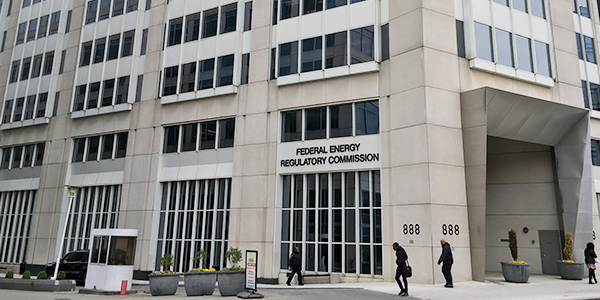FERC on Thursday revised how it enforces the Public Utility Regulatory Policies Act, giving state regulatory commissions more flexibility in how they establish avoided-cost rates for qualifying facilities and the ability to require those rates to vary over the span of a QF’s contract.
States may use fixed energy rates for QFs, but they will also be able to base them on projections of what energy prices will be at the time of delivery.
The commission’s final rule adopted most of the proposals in its Notice of Proposed Rulemaking issued in September last year (Order 872; RM19-15, AD16-6). (See FERC to Reshape PURPA Rules.)
Perhaps most notably, the commission had proposed reducing the threshold for the presumption that QFs in RTO/ISO territories have nondiscriminatory access to the wholesale markets from 20 MW to 1. But in the final rule, FERC adopted a 5-MW threshold.
FERC also gave state regulators more flexibility in administering its “1-mile rule” — the presumption that affiliated QFs located at least 1 mile apart are separate facilities. Regulators will be able to challenge that presumption if the facilities are located more than 1 mile but less than 10 miles apart. Facilities located 10 or miles apart will still automatically be presumed to be separate.
States will also be able to set QF energy rates based on the LMP in wholesale markets. FERC had proposed in the NOPR that the LMP itself represent utilities’ “as-available” avoided costs, but it changed that in the final rule to a rebuttable presumption.
“It’s been my view from the start that FERC should modernize our regulations in ways that not only meet our statutory obligations, but also protect consumers and preserve competition,” FERC Chairman Neil Chatterjee said. “Today’s rule accomplishes those goals. We will continue to encourage QF development while addressing concerns about how PURPA works in today’s electric markets.”
During FERC’s open meeting, held via teleconference Thursday, Chatterjee sought to defend the order against critics who said the commission was trying to effectively repeal PURPA or eliminate its protections for QFs. He asked staff member Joshua Kierstein, of the Office of General Counsel, whether the rule would do that.
“This final rule does not seek to repeal or eliminate any aspect of PURPA, which is a federal law that only Congress can modify,” Kierstein answered in a scripted response. “Congress has required that the commission from time to time revise its regulations implementing PURPA, and that is what this final rule does. … The changes in this final rule will enable the commission to continue satisfying the statutory requirements of PURPA, including that the rules encourage QF development. … The new flexibility the rule gives the states to develop an avoided-cost rate requires that the rate be the avoided-cost rate for the purchasing utility, which is what PURPA requires. …
“We expect that this increased optionality for accurately determining avoided cost will continue to provide encouragement for the development of small power producers and cogeneration, as required by PURPA,” Kierstein said. The rule will also provide more transparency into avoided-cost rate development, “both utilities and their customers, and QFs, are likely to receive more bang for their buck.”
Glick Demurs
As he did with the NOPR, Commissioner Richard Glick issued a partial dissent, saying that the rule would discourage QF development.
Although it included “some modest improvements” over the NOPR, the final rule “still aims to achieve what Congress has failed to do: gut the heart of PURPA, with very little reasoned decision-making,” he said during the meeting.
Glick noted that PURPA requires that utilities can’t treat QFs differently than their own resources, “but today’s final rule ignores this. QFs will no longer be guaranteed an option for a fixed-term contract that makes it easier to finance certain projects. Utilities when they self-sell certainly aren’t subject to such uncertainty.”
Commissioner James Danly responded directly to Glick when his turn came to comment on the rule. “It is inapposite to compare QFs and utilities with regard to guaranteed cost recovery,” he said. “The two types of facilities are in completely different legal and recovery mechanisms.” Congress noted “that QFs are not guaranteed cost recovery and that there’s a certain amount of risk that is assumed.”
Commissioner Bernard McNamee said the rule would continue to encourage QF development while “also ensuring we fulfill our other statutory duty, which is to protect customers from paying excessive rates by ensuring they are not paying more under PURPA contracts than they would if they obtained their power from a utility or the markets.”
In a joint statement, the American Public Power Association, Edison Electric Institute and National Rural Electric Cooperative Association applauded the rule. “FERC’s action will benefit electricity customers while further driving growth in renewable energy,” they said. “PURPA was enacted more than 40 years ago during a national oil crisis to promote increased energy conservation, efficiency and the growth of renewable energy. The energy mix and marketplace have changed significantly since then.”
The Solar Energy Industries Association, however, expressed disappointment. “The overall rule changes approved today will undermine the stated intention of the PURPA statute and stifle competition, allowing utilities to strengthen their monopolies and raise costs for customers,” Katherine Gensler, SEIA vice president of regulatory affairs, said in a statement. “We will continue advocating for reforms that strengthen PURPA and allow solar to compete nationwide.”
The rule takes effect 120 days after its publication in the Federal Register.





